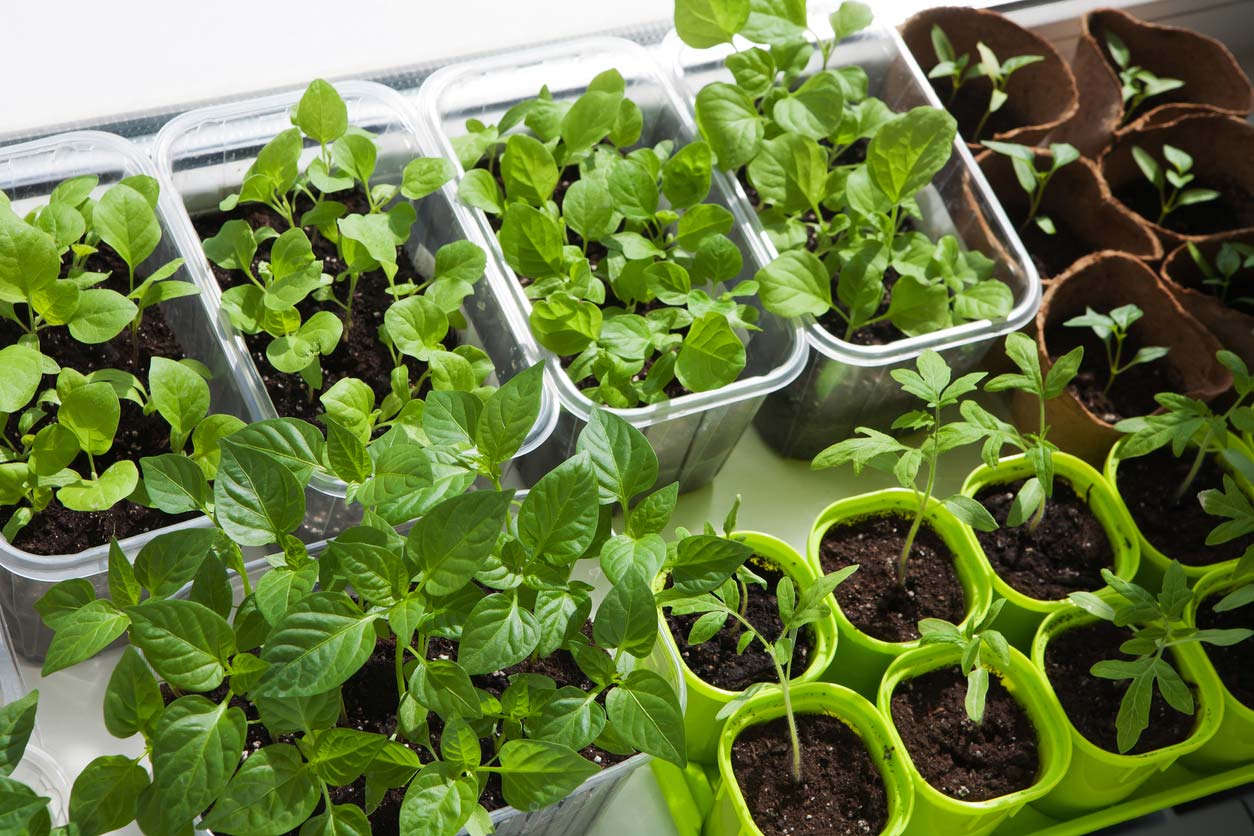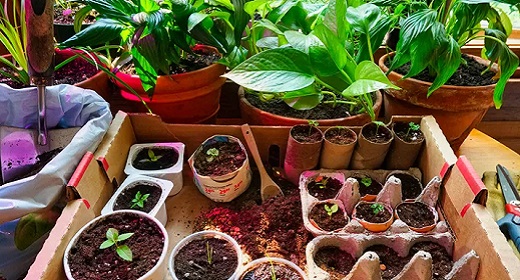by Ocean Robbins: While many retail businesses have been struggling since the pandemic began, garden supply stores have been doing better than ever…
It’s no secret why: We’ve witnessed, for the first time in many of our lives, the fragility of our food supply chain.
Many people have started “victory gardens” or food gardens in response to increased food insecurity and the ongoing disruptions in our food supply. And during a highly stressful time, more of us than ever have turned to gardening to support our mental and physical health.
But outdoor gardening isn’t always possible. Not everyone has the luxury of an outdoor space in which to grow their own food. City dwellers in particular often lack any land on which to sow seeds. Suburban lawns can be too shady to raise food crops. And municipal ordinances or homeowners association rules may prohibit anything but lawns and flower beds in front yards.
Climate may also be an issue. You may live in an area too hot or too cold to grow the kinds of food you like eating. Your growing season may be too short, with not enough daily hours of sun to bring crops to delicious fruition. Or your region may contend with drought, flooding, or both.
And climate change has brought new pests and diseases to gardens across the world. For example, fire ants, which deliver painful bites that can sting and itch for days, delight in the warmer weather. But they are increasingly marching northward and westward in the US for the past decade.
If you’d like to grow some of your own food in spite of any of these obstacles, you may want to start an indoor garden. No, I’m not suggesting emptying wheelbarrows full of topsoil and compost onto your living room carpet. Indoors gardens can be as small or large, simple or complex as you like. In addition to providing you and your family with fresh, locally grown produce, there are a lot of other benefits as well.
Why Start an Indoor Garden?

First of all, indoor gardening is just fun. If you have kids, it’s an easy way to get them excited about healthy food. As “gangsta gardener” Ron Finley puts it, “When kids grow kale, kids eat kale.” As they watch the miracle of a seed sprout and turn into a recognizable plant, they may get hooked on the power, responsibility, and joy of being a steward of nature.
Of course, you have a kid inside you as well. And your “inner child” can get just as excited about indoor gardening as an actual child. You may enjoy experimenting with new foods and new ways of growing food. If you lack the physical strength, stamina, and mobility required for outdoor gardening, you can still enjoy communion with the cycles of life (or, in less highfalutin language, grow some grub) in your own home. As an added bonus, you get to skip the insect bites and pest damage that are common in outdoor gardens. And weeding is more or less unnecessary.
Indoor gardening also allows you to increase the variety of what you eat since you can simulate any season through light and temperature control. Indoors, you’ll be able to grow food that your local supermarket or farmers market might not have for much of the year. Since you control all the inputs, you can assure that your homegrown produce is organic, GMO-free, fresh, and hyper-local. (It doesn’t get any more local than your kitchen windowsill!) And because the plants are so convenient to access and so visible, you’ll be much more likely to harvest and use them regularly. This is especially helpful with fresh herbs, which you can grow in a small space, yet provide big flavor and massive health benefits when consumed frequently.
Setting Up Your Indoor Garden

Now that you’re excited and ready to go (hopefully), let’s roll up our sleeves and get practical. What do you need to set up an indoor garden?
First, find a place to put your plants. You might clear a table, a windowsill, one side of a hallway, or an entire corner of a room. If space is tight, consider a plant stand that can support multiple pots in a vertical configuration. The space you need depends on what you want to grow and how much you want to grow. Conversely, your choice of plants and quantities will be partially determined by how much space you have. You may need to use several surfaces and places around your home.
The big thing about plants is that they grow by converting light into biological energy. In other words, they photosynthesize. This means that your indoor plants should have access to a lot of light during the day. If sunlight isn’t available through windows or skylights, then you’ll need to hook up some grow lights.
And of course, plants are fragile, especially when young, and some can be dangerous if improperly consumed, so you will want to keep them out of the way of rambunctious pets and small, adventurous children.
Indoor Gardening Supplies

Gardening Containers
Since I don’t recommend shoveling piles of dirt onto your hardwood, linoleum, or carpeted floors, you’re going to need to garden in containers. You can use classic flower pots, of course, but don’t limit your options to what’s sold in garden supply stores. In addition to clay or terracotta pots, plastic growing containers, and fancier porcelain or ceramic planters, feel free to use old aluminum baking pans, large plastic “margarine” tubs, or even old kitchen pots and pans. The two requirements for a planter are that it holds the soil, and has enough holes (or can have enough holes added) on the bottom to allow for proper drainage. A drainage saucer of some kind is usually advisable to catch water that flows through the holes.
The size of the pots will depend on what you’re growing. Herbs such as oregano or basil may only need an 8-10” pot, while a dwarf citrus tree may require a 5-15 gallon container. Match the size of the pot to the size of your plant. This may require some transplanting to larger and larger containers as your little green friend grows.
Potting Soil
Next, you’ll need a growing medium. Unless you’re doing something fancy like hydroponics or aeroponics, you’ll probably rely on good old soil. There are many different brands of potting mixes that you can buy in bags of various sizes. If possible, choose an organic mix, and look for products specifically formulated for the vegetables you plan to grow. FoxFarm and Happy Frog are two well-regarded brands of organic potting soil. You can also save a little money by creating a DIY potting mix. While it might be tempting to save a few bucks by digging up some local soil, you might want to be cautious here. You don’t want to bring the problems of the outside indoors, such as pests and harmful fungi.
Also, a lot of soil found near buildings has been contaminated by chemicals used in the construction process. If you have an older property, the dirt around your foundation may have been sprayed with chemicals to kill termites that have since been banned but may persist in the environment for decades. Chlordane, for example, which was widely used in the 20th century until it was banned in the US in 1988, has a half-life of 30 years and has been implicated in the development of type-2 diabetes, lymphoma, prostate cancer, obesity, testicular cancer, and breast cancer.
Lead is another persistent pollutant that can accrue in high concentrations around homes where lead paint was used at some point in time. If you suspect that your soil might be contaminated with lead, you may be able to send a sample to a nearby university or state extension service for a small fee.
Optimal Light for Indoor Gardens
Obviously, your indoor plants need light in order to grow strong and produce nutrient-rich food. Natural outdoor light from windows and glass doors is best, as it contains the perfect spectrum of wavelengths and doesn’t require additional energy to create. East- and west-facing windows provide the most direct light in the summer since the sun is lowest in the sky as it rises and sets. Eastern exposure is generally cooler since the sun rises from that direction and heat has less of a chance to build up there.
If you’re planning on gardening indoors in winter, south-facing windows are just the thing, as they provide the most light on short winter days. In the summer, the sun may be so high in the sky that your plants won’t get enough direct sunlight from that direction.
If outdoor light is in short supply, and you don’t have a bright sunny window to place your plants next to, you’ll need to plug in some artificial lighting. You can spend as little or as much as you want here. Some indoor gardeners report success with inexpensive shop lights, which you can find at home improvement stores for as little as $15 for four linear feet. Most gardening experts recommend more expensive broad-spectrum lights that preserve the same color range as the sun. These lights can be especially helpful for starting seeds. They come in two varieties: LED and fluorescent bulbs. Avoid incandescent bulbs, which put out a lot of heat that can actually burn your plants (not to mention waste energy).
If you have a metal shelving unit, you can hang the grow lights on one shelf and place your seedling trays or other plant containers on the shelf below. This can save space, as you can turn a high shelving unit into a space-efficient vertical garden.
Watering your Plants
Plants also need water to survive. Depending on the temperature and relative humidity of your indoor space, they may need more or less water than if growing outdoors. If you use AC in the summer, your AC unit may be pumping water, as well as heat, out of your indoor air. Pay attention to any signs of dehydration in your plants. Leaves are usually the first parts to show evidence of insufficient water.
Unlike outdoor gardens, which can require sprinklers, drip lines, and/or hours spent in the hot sun squeezing a nozzle attached to the end of a dirty hose, you can do all your indoor watering with a simple watering can. Look for a compact can, especially if you’re starting small. You want to make sure it’s easy to fill from your sink. And look for a watering can with a thin spout so you can easily control the water flow and not overwater.
Fertilizer

When you are growing plants in soil and harvesting any parts of those plants, you will need to replenish the fertility you’re removing. Indoor gardening requires more intensive fertilizing since plants typically need more concentrated nutrients when contained. And every time you water, you’re flushing away some nutrients from the soil.
You can purchase premade fertilizer. Or if you’re feeling adventurous and/or virtuous, you can make your own compost from kitchen scraps and garden waste. While composting is usually an outdoor sport (I don’t know anyone who wants a three-foot heap of rotting food and grass clippings in a corner of their kitchen), there are some indoor composting options that you can implement in close quarters without requiring everyone to wear a gas mask. Two methods include bokashi, in which inoculated bran granules are sprinkled over the compost to “pre-ferment” it and speed up the process, and using worms to turn rotting food into wonderful dark rich soil.
Fertilizer Nutrient Breakdowns
If you’re buying fertilizer, look for products that are specific to the veggies you’re growing. You’ll want to get the right ratio of “macronutrients” (which, for plants, are nitrogen (abbreviated N), phosphorus (P), and potassium (K)). Fertilizers list the amounts of these “big three” in that order. A bag of 10-5-1 fertilizer, for example, contains a concentration of 10 parts Nitrogen, 5 parts phosphorus, and 1 part potassium. It may seem, at first glance, that fertilizer with higher levels of these nutrients is the way to go, but you need to be careful how you apply them, as overdoses can harm plants.
It’s very important to use only organic fertilizers on your indoor crops, as opposed to synthetic NPK. The synthetic version can burn plants through overdoses, and break down too quickly, often leading to gangly plants with poor health, poor structure, and little nutrition. Organic fertilizers are made from natural ingredients, and break down more slowly, to provide a steady diet of nutrients. Think of synthetic fertilizer as highly processed food, and organic fertilizer as whole food. Just like humans thrive on whole foods, so do plants. Two popular types of organic fertilizer for indoor gardening are worm castings and mixtures of soybean and/or alfalfa meal with various types of mineral dust. If you want to garden veganically, without the use of animal products like manure and bone and blood meal, Down to Earth makes a great vegan 3-2-2 fertilizer.
A Tool to Transplant Seedlings
You also need a tool to transplant seedlings from a starter tray into their own pot or larger container. The technical name for such a tool, which looks like a small hand shovel, is a “trowel.” They’re also useful when covering newly planted seeds with soil. Here’s a small, one-piece trowel with inch markings to determine planting depth.
Plant Supports
Certain vegetable plants, like tomatoes, can grow quite tall, while others, such as pole beans, will vine in whatever direction they find support. If you’re growing these overachievers, you’ll want to get some plant supports to keep the plants from sagging, breaking, or overrunning your bookcase. One common method, which is not considered cruel when applied to vegetables, is to put them in cages. Tomatoes, bell and hot peppers, peas and beans, and eggplants all can grow happy and healthy in a sturdy cage.
If you have more space and a bit more ambition, you can start an indoor vegetable garden with vining crops that require full-on trellising to reach their potential. These include cucumbers, grapes, squash, and melons.
Most Importantly… the Seeds!
And of course, you’ll need to invite the featured indoor gardening guest: the seeds or seedlings you’ll be growing. Again, look for organic seeds whenever possible. Since you’re growing them away from pests and diseases, you won’t need to protect them with pesticides or other antibiotic chemicals. You can find organic seeds at hardware stores, nurseries, and some health food stores, as well as online.
Since you’re not growing the plants outdoors, you can ignore the hardiness zone information on the seed packets. You can create whatever climate you like — within reason. While you can probably coax tomatoes and eggplant in December, I don’t recommend getting your heart set on local mangos, avocados, and bananas if you live in Maine.
Seed Starting & Seedlings
If you’re starting lots of seeds at once, use seed starter trays for increased efficiency. You can start up to 72 seeds in a single tray, which is a great form of insurance against some seeds not germinating. These trays often come in plastic, or biodegradable recycled paper, and sometimes have a transparent plastic cover to hold in heat and moisture. You can make a DIY seed starter out of an egg carton, in case you eat eggs or have neighbors who do.
If you get super serious about maximizing your germination rates, you might want to consider investing in a humidity monitor, humidifier, heating mats, and thermostat controller to keep the temperature and humidity of the air and soil at optimal levels.
To save time, you can also start with seedlings that have already germinated. You’ll get the best seedlings from reputable plant nurseries, or from someone you know and trust with your future (plant) offspring.
Best Plants to Grow Indoors

If you’re using grow lights and have the means to control the temperature and humidity, and if you have enough space, you can grow almost anything you desire. But these are some of the best and easiest edible plants to grow indoors.
Herbs
Herbs are easy to grow, as they don’t take up much space, can be harvested continuously for seasonings, and are most comfortable at room temperatures (65-75 degrees Fahrenheit). Some of the best indoor herbs include thyme, sage, chives, mint, basil, rosemary, bay laurel, oregano, chervil, and parsley. The best spot for your indoor herb garden is on a sunny kitchen windowsill if you have one. And if you splurge for some grow lights, you can grow pretty much any herb you like. Give them 12-16 hours of direct light per day, and they’ll thrive.
Leafy Greens
Leafy greens are also solid indoor gardening choices. Many greens are adapted to indoor growing, including loose-leaf lettuce varieties, baby spinach, arugula, and mesclun mix. Kale is a bit more of a challenge, as it does best in cooler temperatures, but you can definitely give it a try.
The easiest way to grow leafy greens is to harvest them as microgreens. It’s a bit more time-intensive since you’re harvesting them young and therefore have to replant frequently due to turnover, but the microgreens are typically extremely high in nutrients, delicious, and easy on resources like soil, water, and fertilizer. Some microgreens can give you multiple harvests from a single crop; just give them a haircut with a sharp pair of scissors, and they’ll grow back as long as you keep watering them and giving them sufficient light. Here’s a handy microgreen starter kit.
Sprouts
Sprouts don’t even require soil; you can sprout greens and other seeds on damp paper towels, or in jars with mesh lids. Here’s a whole article about how to grow sprouts indoors.
Vegetables
You can also grow many vegetables indoors, depending on space and light. Some of the most popular include tomatoes, chili peppers, potatoes, green onions, and carrots. Vegetables can be grown from seeds, seedlings, or even regrown from scraps. Note that you’ll likely need larger containers (at least 10-12″ wide and deep) for most vegetables, especially if you want to grow enough to feed your household.
Fruit Trees
Don’t forget lovely, fragrant, and hardy fruit trees. There are many dwarf varieties of lemon, peach, fig, and other fruit trees. If you like nursery rhymes, you might consider growing a mulberry bush in the middle of your family room.
If you have space and some large containers (2-5 gallons), you can grow delicious berries: blueberries, blackberries, and raspberries are common choices. And there are even varieties of grapes that can be grown indoors.
Higher-Tech Resources for Indoor Gardening

If you’re looking for an indoor gardening system, rather than setting up your own from scratch, there are several “smart garden” companies that allow you to grow your own fruits, veggies, herbs, and flowers using technology.
Hydroponics
Hydroponics involves growing plants in a nutrient-infused water medium, or in sand or gravel, rather than soil. These systems can be highly efficient and reliable. They automate the delivery of water, nutrients, and even light to your plants to ensure great growing conditions and successful crops every time. And because they are so precise, they require much less water, nutrients, and space than traditional soil-based gardening.
The cons of hydroponics are the costs (a home-based system can run you a few hundred dollars), the relatively small output (most of the smaller units are an easy and reliable way to grow a bit of tasty food, but are best used for herbs if you want to make a big impact on your culinary life), reliance on electricity, and the fact that you can get “locked-in” to a particular technology and have to keep ordering seeds, nutrients, and sometimes accessory parts from the same company. Hydroponics is probably a few steps away from what Mother Nature might have intended, but then again, so is much of the modern world, including growing food indoors at all. Sometimes trade-offs make sense as we do the best we can with the resources and opportunities we have available to us.
There are several brands out there. One of the most popular systems is made by Click and Grow, and features their own proprietary “soil” mix that’s made of renewable materials, contains no pesticides or fungicides, and provides all the plants’ water and nutrient needs.
Aeroponics
A newer technology, first developed by NASA, is aeroponics — technically growing in air. The idea is to feed the roots via a fine mist dispersed through the air, rather than submerging them in water or another medium. These systems operate in a very similar manner to hydroponic systems, from a consumer/gardener standpoint. The most popular brand is Aerogarden, and they have many well-reviewed options for different aesthetics and scales. If you’re interested, you can find out more here.
Recipes to Reap the Benefits of your Indoor Garden
Once you grow food, it’s time to use the fruits (and herbs, beans, and greens) of your labors! It feels pretty incredible growing your own food, not to mention when you can grow food indoors. It’s going to feel even better when you can get creative in the kitchen with foods from your garden, preparing delicious and beautiful meals with homegrown ingredients.
1. Herbed Cashew Cheese

A fun and convenient way to use every herb from your indoor garden is to make an Herbed Cashew Cheese. There are no rules for flavoring this cheese — anything goes. We suggest basil, parsley, and chives, but you can use any combination of herbs at hand. Consider dill and parsley, or oregano and thyme, or cilantro and chives. See what we mean about anything goes?
2. Green, Grain, and Sprout Bowl with Garlic Sauce

Want to use your homegrown sprouts in something other than wraps? Sprouts are delicious in grain bowls (and even more delicious when you add a creamy cashew garlic sauce on top!). The bean and alfalfa sprouts used in this recipe are two examples of sprouts but we hope this recipe will inspire you to explore and grow all kinds of sprouts from clover to lentil to broccoli and beyond!
3. Beans and Greens Soup

We could probably call this soup “Everything But the Kitchen Sink” given the abundance of healing ingredients! Here’s an opportunity to use everything you might grow indoors: onions, potatoes, carrots, greens, herbs, and more. Let us know which ingredients you pulled from the comfort of your own home to make this nutrient-dense and flavorful soup.
4. Kale Walnut Basil Pesto

Use kale (or other leafy green you successfully grew indoors!) and basil to make a flavorful pesto that can be used in grain bowls, on whole-grain crackers, as a legume pasta sauce, or on top of avocado toast. It’s packed with omega-3s, folate, carotenoids, magnesium, and much, much more.
5. Blueberry Oatmeal Bars

Did you go for the berry bush in the middle of your living room? Well, we have a recipe just for you! These Blueberry Oatmeal Bars make an easy grab-n-go breakfast or a healthy after-dinner treat. Whenever you enjoy its sweet juiciness, remember that all the effort you put into growing that berry bush is giving back to you with each bite.
Is Indoor Gardening for You?

Indoor gardening isn’t for everybody. It takes time and space, and depending on how you do it, it can cost some money to get set up. But for many people who don’t have a suitable outdoor space, it can be a great option. Indoor gardening is also perfect for wintertime growing if the temperature drops too low where you live to continuously grow a variety of food outside. Once you have a spot to grow in, it’s just a matter of getting the right supplies, figuring out what plants you’d like to grow, and getting rolling.
So if you’ve been stuck at home without access to an outdoor garden, fantasizing about all the crops you can’t grow, now’s your chance to develop an indoor green thumb. If you’re overwhelmed by all the options, start small. Once you get hooked on fresh, local, organic, and delicious food you grew yourself, the sky — or more likely your ceiling — is the limit. Enjoy your food in good health. And happy growing!










































